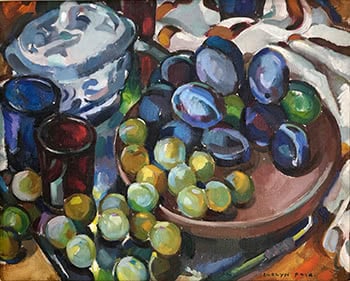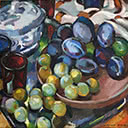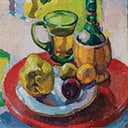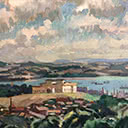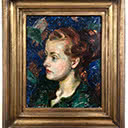Still Life and Fruit
32 x 40.2 cm
PROVENANCE
Paul & Kerry Barber Collection
Fine Art, Dunbar Sloane 27/08/2003
In the publication accompanying the Seven Decades exhibition at Robert McDougall Art Gallery, Janet Paul and Neil Roberts describe the visual rhythm of Evelyn Page's work - Her real subject was the complex vitality in the movement and colour of paint itself.
These two works Still Life and Fruit and Still Life with Fruit and Wine from the Barber Collection are superb examples of this complex vitality. Both have an even-toned richness - the result of smooth, fluid brushstrokes breaking down the boundaries between surface and vessel and fruit.
In these paintings, compositional freedom contrasts with precision of form. Look closely and consider the harmonious effect of both works: although the arrangements appear fluid and without boundaries, each object is jewel-like and definite, and the integrity of each glass or piece of fruit is intact.
These are orderly, quiet paintings of interior arrangement. The colours are not particularly bright or vibrant. And yet, there is a thrum beneath the surface which you can't help but appreciate; a delicate sense of life and serenity. Light is refracted through the coloured glass and off the smoothly shining surfaces of fruit, blurring the outer limits of these domestic objects.
Going all the way back to when Page attended the Canterbury College School of Art as a teenager, she showed that she was not inclined to follow trends in contemporary painting. Even when living in the UK and travelling around Europe (and at a time when many of her contemporaries' work was being directly influenced by the French Impressionists), she consciously took her cues from more traditional, academic schools of thinking, and was inspired by artists such as John Constable.
As a result of this adherence to her classical training, Page developed a succinct and recognisable painted language that was uniquely her own. Her pursuit of pure colour and form was not inspired by the avantgarde, but was something which she arrived at on her own terms. Looking at Still Life and Fruit and Still Life with Fruit and Wine, it is more helpful to draw links between their style and developments in Page's own career and life, rather than with any broader developments in New Zealand art at the time. Consider, for example, the fact that she was a lover and aficionado of music, and how this translates to a strong sense of rhythm in her work.
Though undated, these works would most likely have been painted in the later stages of Page's career. From the 1960s, a struggle with arthritis had forced her to apply a more domestic, introspective lens to her work, and she started to regularly paint still lifes. Right through to the 1980s, she worked with great fervour and dedication to produce fine compositions such as these.

